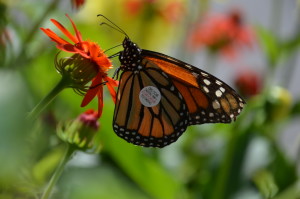*Blog is guest authored by Joy Stewart, University of Tennessee Master Gardener. She lives in Bristol, TN.
For such a small creature, weighing in at only half a gram, the Monarch butterfly has almost more remarkable facts and puzzling mysteries attached to it than one can count. No other butterfly in the world migrates like the Monarchs of North America.
Since they cannot survive cold weather, Monarchs must travel to warmer climates in winter. Monarchs west of the Rocky Mountains travel to the California coast. Monarchs east of the Rockies travel to the mountains in Mexico. They fly up to 3,000 miles, much farther than all other tropical butterflies. Since each individual butterfly only makes the trip once, butterflies heading south in the fall are the great great grandchildren of those that left their winter roosts the previous spring. Yet returning butterflies fly in masses to the same winter roosts, often to the exact same spot they left four generations ago.
Monarch Watch is a non-profit program dedicated to protection of Monarch butterflies through education, conservation and research. It is based at the University of Kansas, Lawrence, KS. Their activities include a Monarch tagging program whose purpose is to trace a butterfly from its point of capture to its point of recovery. Tagging data are used to determine pathways that butterflies take during migration, the influence of weather on migration, and Monarch survival rates.
Individuals can order tag kits from Monarch Watch, which include instructions on how to safely net Monarchs, how to apply the tags, and how to record and report your data. Tagging begins in late August in all regions of the US, and most data are collected in September and early October.
Even if you don’t tag a butterfly yourself, you can participate by reporting butterflies that you have spotted with a tag. Each tag contains an ID composed of letters and numbers plus a phone number and e-mail address for making your report.
Peak Monarch migration southward from the mid-Atlantic states occurs from September 18 through October 1. A simple accurate way to remember these dates is to watch for New England Aster and goldenrod to start blooming and you will know Monarch migration is underway.


 Posted in
Posted in 
